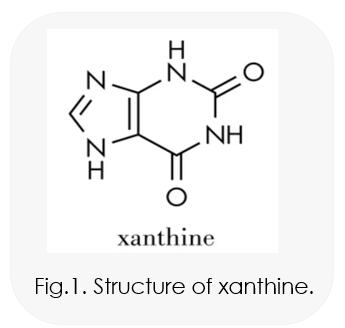Introduction

Xanthine (1H-purine-2,6(3H,7H)-diones) is purine based natural heterocyclic alkaloids found in most human bodies and other organisms. It is a product of de novo synthesis of purine or degradation of adenosine monophosphate (AMP) in the body, through a process known as purine metabolism. Its structure consists of two furanose rings fused to a five-membered imidazole ring. Xanthines in various forms (In other words, there are a lot of xanthines derivatives), such as caffeine, theophylline, theobromine, etc., are abode in tea, coffee, cocoa, chocolate etc. [1] These compounds have nucleotide phosphodiesterase inhibition, antagonization of adenosine receptor, anti-inflammatory, anti-microbial, anti-oxidant and anti-tumor activities, making them widely used in pharmaceutical fields to treat various disease such as asthma and other respiratory diseases. As a reliable supplier of xanthines, we house top-notch pharma grade xanthine and related products that cater to manifold pharmaceutical applications.
Our Xanthine Series Products
*Products with other standards and packing specifications can be customized according to customer's needs.
Typical Xanthine Derivatives
Xanthine forms an array of derivatives that serve distinct biological functions in the body. Notable among these are caffeine, theophylline, and theobromine, which are classified as methylxanthine derivatives.
- Caffeine (1) is perhaps the best-known xanthine derivative and is found naturally in beverages such as coffee and tea. It is known to stimulate the central nervous system, thereby reducing physical fatigue and restoring alertness.
- Theophylline (2), another methylxanthine, is found predominantly in tea leaves. It is often used in medicine for its bronchodilatory properties and is thus an important therapeutic option for managing conditions such as chronic obstructive pulmonary disease (COPD) and asthma.
- Theobromine (3), yet another member of the methylxanthine family, is predominantly found in cocoa and chocolate. It is known for its diuretic, stimulant, and vasodilator effects. Interestingly, it also helps in cough suppression.
- Other xanthine derivatives also include compounds like paraxanthine (4), xanthosine and xanthine monophosphate.
 Fig.2. Chemical structure of xanthine derivatives.
Fig.2. Chemical structure of xanthine derivatives.
Applications of Xanthine Derivatives in Disease Treatment

- Remarkably, xanthine derivatives hold immense therapeutic potential. The most evident use of these molecules is in the management of respiratory diseases, mainly asthma and COPD. Theophylline, for instance, belongs to the class of bronchodilators and serves to relax and open air passages in the lungs, thereby improving breathing. The drug's anti-inflammatory and immunomodulatory activities also play crucial roles in COPD management. Accordingly, theophylline has been a cornerstone in the treatment of these respiratory conditions for decades. Caffeine, as a xanthine derivative, has shown noteworthy effects in neonatology. In preterm neonates, caffeine is extensively used to treat apnea of prematurity owing to its central nervous system stimulant effects and ability to enhance diaphragm function.
- In addition, research suggests the potential of some xanthine derivatives in the management of neurodegenerative diseases. For example, these compounds, particularly caffeine, have shown properties for reducing the risk and delaying the onset of Parkinson's disease. They have also been found beneficial in cardiovascular illnesses by providing protection against heart diseases by inhibiting myocardial damage. Besides, they also demonstrated benefits in renal disease treatment.
In conclusion, xanthine and its derivatives represent a fascinating class of compounds with diverse pharmacological properties, playing influential roles in many therapeutic areas. Despite the inception of newer drugs, xanthine derivatives have maintained their relevance, owing to their broad spectrum of benefits.
Our company takes the lead in furnishing high quality, pure and safe xanthine derivatives products, and we offer a comprehensive and competitive range of xanthine derivatives products that stand up to various pharmaceutical applications. Moreover, we also provide custom synthesis services according to customer requirements. If you are interested in our products or have any questions or needs, please feel free to contact us. We will be happy to provide you with support and services.
Through a relentless pursuit of excellence and an unparalleled commitment to customer satisfaction, we have gained an impeccable reputation in the industry!
Reference
- Singh N., et al. Xanthine scaffold: scope and potential in drug development[J]. Heliyon, 2018, 4(10).
Related Products
It should be noted that our service is only used for research, not for clinical use.


 Fig.2. Chemical structure of xanthine derivatives.
Fig.2. Chemical structure of xanthine derivatives.